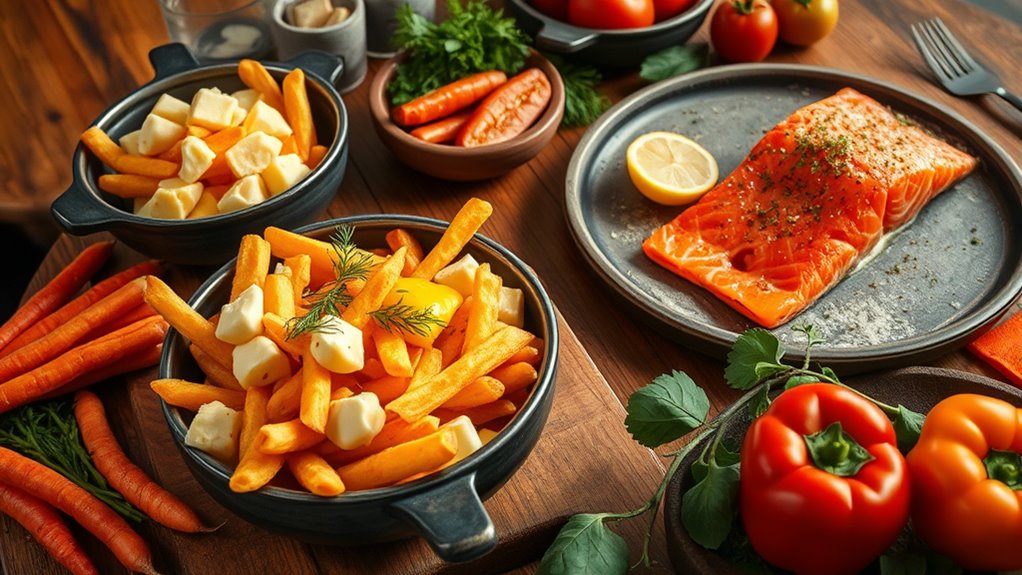Ontario’s culinary traditions blend Indigenous land-based practices with European influences and vibrant multicultural flavors. You’ll find traditional foods like bannock, pemmican, and maple syrup, alongside hearty stews and baked goods. Modern cuisine combines seasonal local ingredients with global spices and techniques, creating innovative dishes. Indigenous revitalization efforts and cultural festivals highlight the rich heritage. To discover how these diverse elements come together, explore further and uncover Ontario’s unique food story.
Key Takeaways
- Ontario’s culinary traditions blend Indigenous ingredients and techniques with European settler influences, emphasizing seasonal preservation and land-based foods.
- Indigenous foods like wild berries, freshwater fish, and pemmican are being revived through festivals and cultural initiatives.
- Traditional methods such as smoking, earth oven cooking, and open-hearth baking are integrated into modern Ontario cuisine.
- The province’s food scene features a fusion of local ingredients with global flavors, reflecting Ontario’s multicultural population.
- Seasonal produce and preservation techniques ensure year-round access to fresh foods, inspiring innovative culinary practices.
Indigenous Culinary Foundations in Ontario

Indigenous peoples in Ontario have long relied on the land’s natural resources to shape their diets and cooking practices. You learn to gather wild game, freshwater fish, berries, and foraged plants, using them as staples in your meals. Preservation methods like smoking, drying, and roasting are essential for surviving harsh winters. You might prepare bannock, a simple bread cooked over an open flame, or make pemmican, a nutrient-dense mixture of dried meat and fat. Indigenous techniques, such as stone boiling and earth ovens, influence many cooking methods used today. Maple syrup harvesting, rooted in Indigenous knowledge, becomes a key ingredient, highlighting the deep connection between land and cuisine. Understanding traditional raw food preservation methods can deepen appreciation for Indigenous culinary heritage. These traditions form the foundation of Ontario’s Indigenous culinary heritage.
European Settler Influences and Early Cuisine

When European settlers arrived in Ontario, they brought with them culinary traditions that began to shape the region’s early food landscape. You can imagine the aroma of French tourtière baking in the oven or the sizzle of roast beef at a Sunday feast. These influences blended with Indigenous ingredients and techniques, creating new dishes. You might see:
- French dishes like tourtière and rich sauces, using local game and vegetables
- English staples such as roast beef, puddings, and hearty stews
- Dutch and Scandinavian flavors arriving later, adding hearty baked goods and preserved foods
- Pioneer methods like open-hearth baking, smoking meats, and seasonal preservation techniques
- The use of versatility in traditional cooking to adapt ingredients for different dishes and preservation needs
This fusion of traditions resulted in a unique early cuisine that balanced resourcefulness with cultural exchange, laying the groundwork for Ontario’s culinary identity.
Modern Ontario Culinary Identity and Foodways
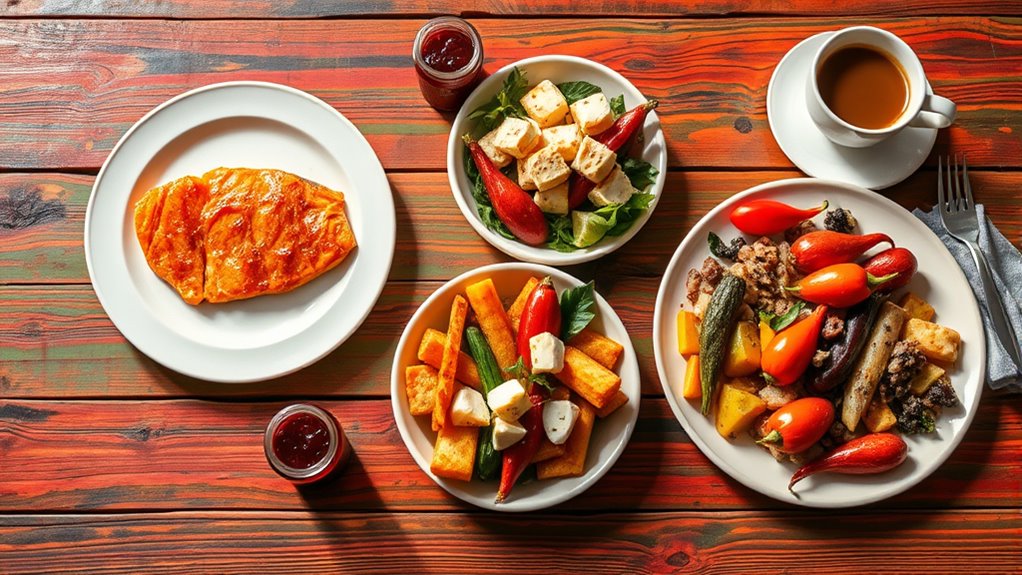
You see how Ontario’s culinary scene blends local ingredients with global flavors, creating a diverse and dynamic food identity. Seasonal produce and preservation techniques still shape menus, ensuring year-round freshness and tradition. Meanwhile, Indigenous foods are being actively revived, adding heritage and sustainability to Ontario’s modern cuisine. Additionally, embracing limits and constraints can inspire chefs to innovate within regional and cultural boundaries, fostering unique culinary creations.
Fusion of Local and Global
How does modern Ontario cuisine reflect a dynamic fusion of local ingredients and global influences? You’ll notice chefs blending Ontario’s fresh, seasonal produce with diverse culinary traditions from around the world. This creates dishes that honor local heritage while embracing innovation. For example:
- Incorporating Asian spices into Ontario-grown vegetable stir-fries
- Using traditional Indigenous techniques with Mediterranean ingredients
- Combining French pâté methods with local game meats
- Infusing Caribbean flavors into Ontario seafood dishes
This fusion results in a vibrant culinary scene where global techniques meet regional ingredients. Chefs experiment with flavor profiles and presentation, reflecting Ontario’s multicultural makeup. The approach not only celebrates heritage but also pushes culinary boundaries, making Ontario’s food culture both diverse and forward-looking. Resources and Tools
Seasonal Ingredient Use
Modern Ontario cuisine relies heavily on seasonal ingredients, reflecting the region’s diverse climate and agricultural calendar. You’ll find springtime features like fresh asparagus, peas, and wild greens, while summer brings an abundance of berries, tomatoes, and corn. Fall signals the harvest of apples, pumpkins, squash, and root vegetables, which are preserved through canning and drying. Winter dishes often incorporate preserved foods, smoked meats, and hearty stews made from ingredients stored from previous seasons. Chefs and home cooks alike adapt to these cycles, using preservation methods such as pickling, drying, and fermenting to guarantee year-round access to fresh flavors. This seasonal approach not only emphasizes freshness but also honors Ontario’s agricultural rhythms, allowing you to enjoy the region’s bounty at its peak. Additionally, understanding the foodways of Ontario helps in appreciating how culinary traditions evolve with seasonal availability.
Indigenous Food Revival
Have Indigenous culinary traditions found a renewed voice in Ontario’s vibrant food scene? Absolutely. Today, chefs and artisans are embracing Indigenous ingredients and techniques to reimagine traditional dishes. You might see dishes featuring wild berries, freshwater fish, or game, prepared with methods like smoking or earth oven cooking. Indigenous food festivals celebrate heritage and promote sustainability, highlighting the importance of local ingredients. Some key aspects include:
- Reviving traditional ingredients like wild berries, maple syrup, and foraged plants
- Incorporating Indigenous cooking techniques such as smoking and earth oven baking
- Collaborating with Indigenous communities to ensure authentic representation
- Promoting sustainable harvesting and respect for natural resources
- The use of electricity production from bike generators exemplifies sustainable practices that can be integrated into food events to reduce environmental impact.
This resurgence enriches Ontario’s culinary identity, blending heritage with modern innovation and honoring Indigenous foodways.
Signature Ingredients and Iconic Dishes in Ontario

Ontario’s signature ingredients and iconic dishes reflect a rich blend of indigenous traditions, immigrant influences, and local produce. Maple syrup stands out as a cultural cornerstone, used in everything from breakfast spreads to desserts. Locally sourced beef, often from Alberta, features prominently in hearty meals, while Atlantic and Great Lakes fish highlight Ontario’s seafood flavors. Berries, apples, and foraged plants showcase the region’s natural bounty, incorporated into preserves, baked goods, and beverages. Here’s a deeper look:
| Ingredient / Dish | Significance |
|---|---|
| Maple syrup | Indigenous origin, symbol of Ontario’s heritage |
| Poutine | French-Canadian influence, comfort food |
| Freshwater fish | Sustainable local seafood, regional identity |
| Wild berries & apples | Seasonal harvest, natural flavor enhancement |
These elements exemplify Ontario’s culinary identity—rooted in tradition, enriched by diversity. Furthermore, embracing local ingredients supports sustainable practices and enhances the authenticity of regional cuisine.
Immigrant and Multicultural Contributions
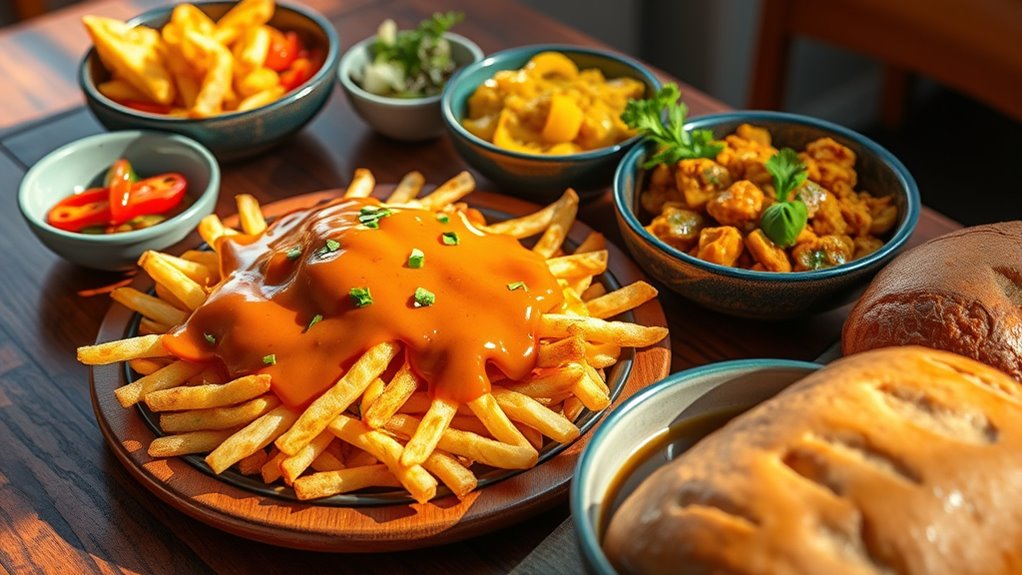
You see how Ontario’s food scene is shaped by a rich mix of cultures, each adding unique flavors and techniques. Immigrants from Europe, Asia, the Caribbean, and beyond bring their traditions, creating a vibrant fusion of culinary styles. This blending of diverse heritage continues to evolve, making Ontario’s cuisine both dynamic and deeply rooted in history. Additionally, culinary traditions from various regions influence local food practices, enriching Ontario’s gastronomic landscape.
Diverse Culinary Heritage
Immigration has profoundly shaped Ontario’s culinary landscape, bringing a rich tapestry of flavors and techniques from around the world. You can see this diversity in the vibrant foods you encounter across the province. For example:
- Ukrainian, Polish, and German dishes like pierogi, sausages, and cabbage rolls fill many communities.
- Jewish immigrants introduced bagels and smoked meats, now staples in urban centers.
- Asian cuisines influence street foods, sushi bars, and fusion restaurants, adding bold flavors.
- Caribbean and South Asian spices spice up local menus, reflecting Ontario’s multicultural fabric.
- Recognizing professional help can also be instrumental in navigating the complexities of cultural integration and culinary adaptation.
This blend creates a dynamic food scene where traditional recipes merge with local ingredients. Your culinary experience is a reflection of Ontario’s history—an ongoing story of migration, adaptation, and celebration through food.
Fusion Food Trends
Multicultural contributions have transformed Ontario’s culinary scene into a vibrant mosaic of flavors and techniques. You’ll find that immigrant communities bring their traditional ingredients and dishes, blending them seamlessly with local and Indigenous foods. For example, Asian fusion restaurants combine sushi with Ontario-grown produce or incorporate spices from South Asia into classic dishes. Caribbean and Middle Eastern influences add bold spices and cooking styles to everyday meals. You might enjoy tacos filled with pulled pork or pierogi topped with Asian-inspired sauces. Chefs experiment by merging culinary methods, creating innovative dishes that reflect Ontario’s diverse heritage. This fusion fosters a dynamic food culture, where tradition and innovation coexist, making Ontario’s cuisine both exciting and deeply rooted in its multicultural identity. Additionally, smart IoT technologies are increasingly being used in modern kitchens to monitor and optimize cooking conditions, allowing for more precise and innovative culinary creations.
Traditional Culinary Techniques and Preservation Practices
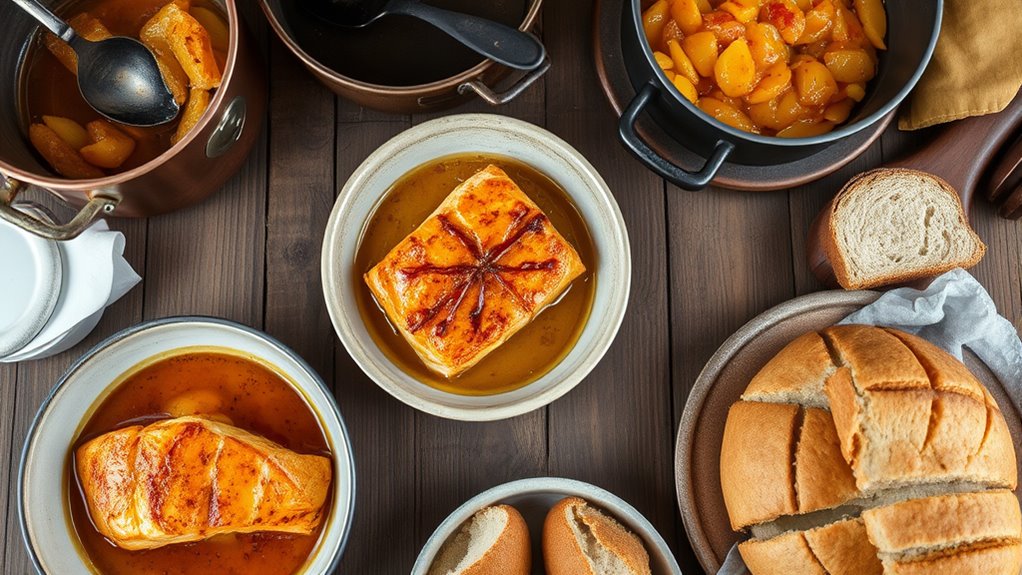
Traditional culinary techniques and preservation practices have played a crucial role in Ontario’s food heritage, allowing communities to make the most of seasonal harvests and guarantee food security during harsh winters. You’d see methods like open-hearth cooking with cast iron Dutch ovens, stone boiling, and earth ovens, which imparted unique flavors. Smoking houses preserved meats and fish, ensuring supplies lasted through winter. Outdoor bake ovens served as communal spaces for baking bread and preparing meals. Seasonal harvests relied on pickling, canning, drying, and churning butter to extend shelf life and maintain nutrient value. These practices fostered self-sufficiency and community bonds. Today, heritage cooking demonstrations help keep these skills alive, connecting you to Ontario’s rich culinary past and emphasizing sustainable, traditional food practices.
Indigenous Revitalization and Contemporary Food Movements

Indigenous communities in Ontario are actively revitalizing their culinary heritage by reclaiming traditional ingredients and cooking techniques. You’ll find efforts to preserve and share recipes that highlight wild game, freshwater fish, berries, and foraged plants, reconnecting with ancestral foodways. Modern chefs and community programs emphasize sustainable practices, locally sourcing ingredients, and honoring cultural stories behind dishes. Indigenous-led food festivals and markets showcase signature items like bannock, pemmican, and maple syrup, blending tradition with innovation. These movements also focus on education, teaching younger generations about heritage foods and techniques such as smoking and earth ovens. By doing so, they foster pride and resilience, ensuring Indigenous culinary traditions remain vibrant and relevant in Ontario’s evolving food scene.
Seasonal Variations and Culinary Innovation
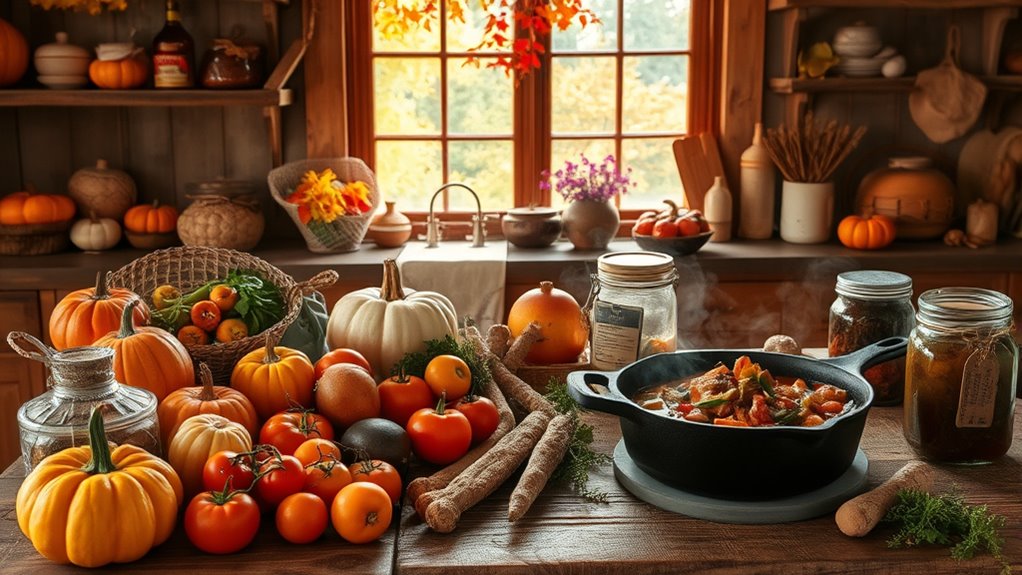
As Indigenous communities and chefs continue to revive heritage ingredients and techniques, they also embrace the changing seasons to create innovative culinary experiences. You’ll notice seasonal variations inspiring new dishes that celebrate Ontario’s diverse landscape. Chefs leverage fresh, local ingredients at peak harvest times, then adapt preservation methods for off-season availability. Imagine:
- Using spring wild garlic and fiddleheads for vibrant salads and pestos.
- Preserving summer berries as jams, syrups, and infused spirits.
- Roasting root vegetables and squashes in autumn for hearty stews.
- Incorporating winter’s maple syrup into desserts, glazes, and drinks.
This cycle pushes culinary boundaries, blending traditional preservation with modern techniques. The result is a dynamic food scene that respects heritage while continuously evolving, highlighting Ontario’s seasonal bounty and inventive spirit.
Frequently Asked Questions
How Have Indigenous Ingredients Influenced Modern Ontario Cuisine?
Indigenous ingredients heavily influence your modern Ontario cuisine by inspiring chefs to incorporate wild berries, maple syrup, freshwater fish, and foraged plants into their dishes. You’ll find traditional elements like bannock and pemmican reimagined with contemporary techniques, emphasizing sustainability and heritage. These ingredients also drive seasonal menus and artisanal products, celebrating Ontario’s natural bounty and Indigenous culinary roots, enriching your dining experience with authentic, local flavors rooted in history.
What Role Do Traditional Preservation Methods Play Today?
Traditional preservation methods are the backbone of Ontario’s culinary heritage, like roots anchoring a mighty tree. They keep your food safe through winter’s chill, ensuring freshness and flavor endure. Today, chefs and home cooks revive smoking, drying, and canning techniques, blending old-time skills with modern flair. These methods connect you to the land’s rhythms, allowing you to savor seasonal bounty year-round and honor Ontario’s rich culinary history.
How Do Immigrant Cuisines Shape Ontario’s Culinary Landscape?
Immigrant cuisines greatly shape Ontario’s culinary landscape by blending their traditional ingredients and techniques with local flavors. You see this in the popularity of pierogi, sausages, and Asian street foods across the province. These influences create a diverse food scene where new dishes emerge through fusion, reflecting the multicultural makeup of Ontario. You’re encouraged to explore authentic immigrant eateries and experience how their rich traditions add vibrant layers to Ontario’s culinary identity.
What Are the Key Techniques Used in Ontario’s Heritage Cooking?
You’re diving into Ontario’s heritage cooking techniques—think ancient methods so powerful they’ve shaped centuries! You’ll see open-hearth cooking with cast iron kettles, stone boiling that transforms simple ingredients, and earth ovens that create flavors beyond imagination. Smoking houses preserve meats and fish, while pickling and drying turn seasonal bounty into year-round treasures. These time-tested techniques make Ontario’s culinary history as vibrant and enduring as the land itself.
How Is Indigenous Cuisine Being Revived in Contemporary Restaurants?
You’ll see Indigenous cuisine being revived in Ontario restaurants through the use of traditional ingredients like wild berries, game, and maple syrup, often highlighting their cultural significance. Chefs incorporate ancestral techniques such as smoking, earth ovens, and foraging, blending them with modern culinary styles. This movement emphasizes sustainability and heritage, allowing you to experience authentic flavors while honoring Indigenous knowledge and storytelling through innovative dishes that celebrate Ontario’s rich Indigenous roots.
Conclusion
As you explore Ontario’s vibrant culinary landscape, picture bustling markets bursting with fresh produce, aromatic spices filling the air, and dishes that tell stories of tradition and innovation. From Indigenous roots to multicultural influences, each bite reflects a rich tapestry of history and modern creativity. Embrace the seasonal flavors and culinary innovations that keep Ontario’s food scene alive and evolving. Your palate becomes a journey through time, culture, and the land itself.

